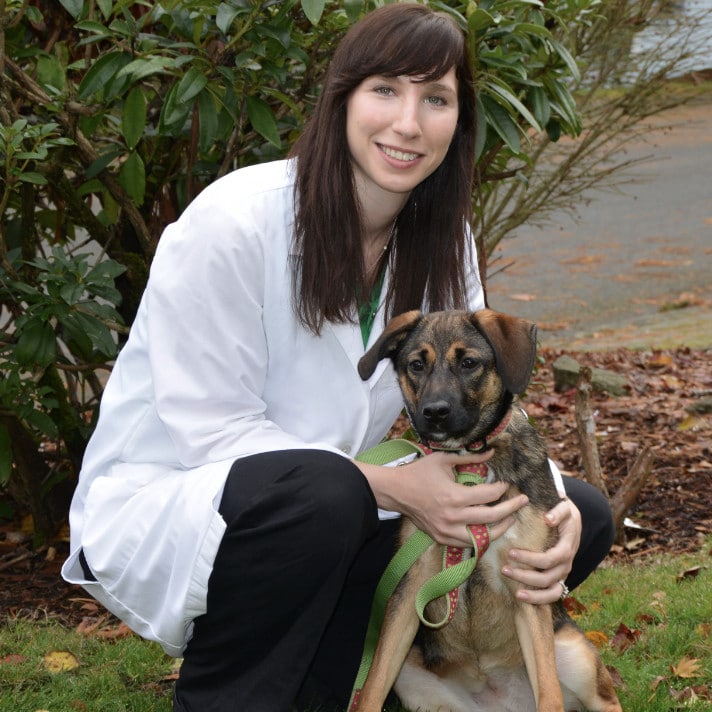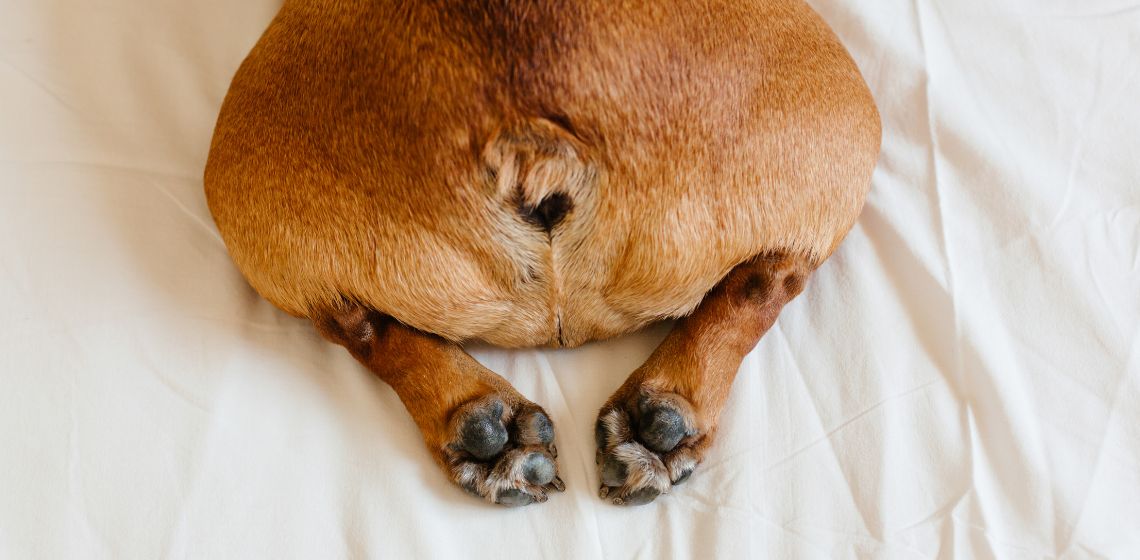Table of Contents
What are anal glands and what do they do?
Anal glands, also known as anal sacs, are two small pouches located under the skin near your dog’s anus, at the 4 and 8 o’clock positions. These glands can range from the size of a pea to that of a grape and contain an oily, foul-smelling liquid that serves as an individual scent marker for your dog. Each anal gland has a small duct connecting it to the end of the anal canal. During defecation, the passage of stool naturally compresses these glands, causing them to release fluid. This unique scent helps mark their territory and relay a message to other dogs.
Anal glands can also release fluid in response to external pressure (for example, licking or butt scooting) or unconsciously in times of fear or stress. However, certain factors, such as genetics, your dog’s diet, and underlying health issues, including obesity, allergies, or gastrointestinal disease, can affect this normal process. This causes the anal glands to become overly full and can lead to several potential issues for your dog.
Common anal gland problems
Sometimes, anal glands don’t function as they should. Common anal gland issues in dogs include:
- Impaction: The glands fail to empty properly, leading to discomfort and a build-up of smelly fluid.
- Sacculitis: Inflammation of the glands, which can be quite uncomfortable.
- Infection: Bacteria can enter the glands, causing pain, swelling, and discharge.
- Abscess: If an infection progresses, it can form a painful abscess, which may eventually rupture.
- Tumors: Unfortunately, cancer can affect many different body parts, including the anal glands, although this is not as common.
Symptoms of anal sac disease
Anal gland issues can be very uncomfortable for your dog. Keep an eye out for signs and symptoms, and schedule an appointment with your veterinarian if you notice the following:
- Scooting: A telltale sign, where your dog drags their bottom along the ground.
- Licking or biting: Excessive attention to the rear end, often due to irritation or pain.
- Discomfort during defecation: Straining, whimpering, or crying out while pooping.
- Fishy odor: The most obvious indicator, a strong, foul smell coming from the anal area.
- Swelling: Visible redness or swelling near the anus.
- Discharge: Blood or pus may be present if an abscess has developed and ruptured.
- Change in tail position: Holding the tail down, chasing the tail, or biting at the base of the tail
- Behavioral changes: Anal gland disease can be very painful, causing some dogs to be irritable or even aggressive
Anal gland expression
To diagnose anal gland issues, your vet will gather a medical history from you and conduct a nose-to-tail physical exam (including a rectal exam). Additional tests, such as fecal exams, allergy tests, or cytology (collection and evaluation of cells), may be necessary to rule out other possible causes.
In many cases, your dog may be leaking anal gland fluid simply because the glands are overly full. In this case, your vet may be able to resolve the issue by manually expressing your dog’s anal glands. The appearance of the anal gland fluid can also help them determine if other care is needed.
There are two methods that can be used to express the anal glands.
- External expression: Involves applying gentle pressure on the outside of the anus. This method is often offered by groomers or can even be done at home after proper instruction. However, if performed incorrectly, it can cause irritation and may not fully empty the anal glands.
- Internal expression: Requires a veterinarian or trained professional to insert a gloved finger into the dog’s anus to locate and squeeze the glands. This is much more effective at fully emptying the glands and also allows the vet to assess your dog’s internal health.
Treatment for anal gland problems in dogs
Depending on the nature and severity of your dog’s anal gland issues, your veterinarian may recommend additional treatments such as:
- Antibiotics: Oral antibiotics are needed to treat anal gland infections or abscesses.
- Anti-inflammatories: These medications help relieve pain and inflammation associated with anal gland disease.
- Sedation: Depending on your dog’s pain level, your vet may recommend sedating them to express and flush the anal glands or instill medication directly into the glands.
- E-collar: A cone is needed to prevent your dog from licking and chewing at the affected area, which can cause further damage or infection.
- Warm compresses: Warm compresses several times per day can provide relief for pain and swelling associated with abscessed anal glands.
- Dietary changes: A high-fiber diet or fiber supplement can bulk up stools and help promote natural anal gland expression.
- Repeated anal gland expression: Some dogs with recurring issues may need to have their anal glands expressed as frequently as once a month. However, expressing the anal glands too frequently in healthy dogs can actually cause problems.
- Treatment of underlying issues: If your dog has allergies, gastrointestinal disease, or other underlying conditions contributing to their anal gland disease, your vet will recommend additional treatment to address this.
- Surgery: In chronic or recurrent cases, or if there is a tumor present, surgical removal of the anal gland(s) may be needed. While surgery is generally extremely successful, this is a complex procedure and can lead to complications such as fecal incontinence.
How to prevent anal gland disease
Preventing anal gland problems primarily involves maintaining a healthy digestive system and regular, firm bowel movements. Here are some key strategies:
- Feed a high-fiber diet: Fiber is essential for gastrointestinal health. It adds bulk to the stool, making it firmer and larger, which puts more pressure on the anal glands during defecation, helping them empty naturally. You can add fiber to your dog’s diet by feeding a prescription high-fiber diet or by adding pumpkin puree or a fiber supplement after consulting your veterinarian.
- Maintain an ideal body weight: Obesity is a major risk factor for anal gland issues, as well as other health problems. Keep your dog in an ideal body condition by feeding a WSAVA-compliant diet, feeding an appropriate amount at each meal, avoiding too many treats or table scraps, and providing regular exercise.
- Exercise them every day: While some dogs are more active than others, daily walks and playtime promote healthy bowel movements and overall well-being.
- Consider probiotics: These “good” bacteria help gut health and improve stool quality, which may be beneficial for dogs with anal gland issues.
- Avoid unnecessary anal gland expression: Unless recommended by your vet, it is best to let dogs express their anal glands naturally during bowel movements. In a dog with healthy anal glands, frequent manual expression can actually cause problems.
- Keep up with regular veterinary checkups: Schedule routine vet checkups to monitor your dog’s health and catch any potential issues early, when they may be easier and less costly to treat.
Luckily many dogs never have any issues with their anal glands, but some may be predisposed due to their breed, genetics, or medical history. Being mindful of your furry family member’s diet, weight, and overall health can significantly reduce their risk of anal gland problems and ensure they stay comfortable, happy, and smelling fresh.
FAQ
Scooting and excessive licking are common signs of anal gland problems, which can be extremely painful. It’s important to contact your veterinarian right away for an examination and appropriate treatment.
Most dogs don’t need routine anal gland expression. It’s only necessary if your dog shows signs of problems or if your vet recommends it based on their history or individual needs.
It’s certainly possible for some pet parents to learn how to express their dog’s anal glands at home. However, having your veterinary team express the anal glands internally is often safer and more effective, especially if they are showing any signs of discomfort or infection.
Surgical removal of the anal glands is usually reserved for chronic and severe cases. The best way to help prevent anal gland issues is to feed an appropriate amount of fiber, keep your dog at an ideal weight, stay up to date on veterinary care, and follow your vet’s advice regarding anal gland expressions.

Liza is a veterinarian who graduated from MSU CVM in 2013 and spent five years working in small animal practice. She loved working with dogs and cats and educating owners on all aspects of veterinary medicine, especially animal behavior and dermatology. She has since transitioned to remote work to be able to spend more time at home with her husband, two young kids, and two cats. She is thrilled to be able to combine her passions for veterinary medicine and writing. She is licensed as a veterinarian in Washington State.








